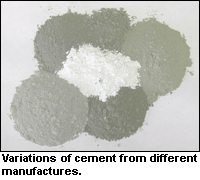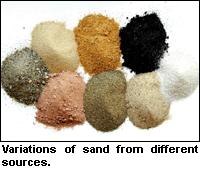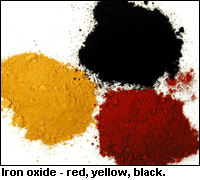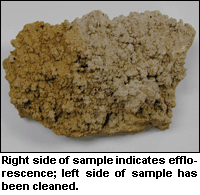Designing with Colored Masonry
By Rich Solomon

Choosing a mortar color to compliment the wide range of colors found in clay brick, colored block, and stone is a sure way to enhance the appeal of a masonry structure. Brick, colored block, and stone contain thousands of hues, which change throughout the day as the reflection of light is altered by brightness and angle. The same is true of colored mortar. Mortar color should be utilized as a design tool to create a totally different look depending upon the color shade selected. It is important to remember that mortar joints make up 18 to 20% of the wall surface. For this reason the utilization of colored mortar will dramatically change the overall appearance of the structure.
Most people are not aware of the normal variations in regular uncolored mortar. When color is used on a project, the expectations concerning the final outcome are generally heightened. There are many factors that directly impact the appearance of a colored mortar joint besides the addition of iron oxide pigments. Variations in cement, sand, water to cement ratio, rate of hydration, environmental conditions, tooling of the mortar joints, and cleaning procedures can change the appearance of colored mortar. The first step toward achieving a consistent mortar color is using the same ingredients and procedures throughout the job. The following criteria should be considered when specifying and producing a particular mortar shade:
- Cement Shade
- Mortar Mix Design
- Color Pigments
- Masonry Procedures
Cement Shade
 Masonry and Portland cement are produced with different manufacturing processes offering a variety of shades from light gray to dark gray color tones. The cement color shade will have a pronounced direct effect towards the mortar color. Adding color to light gray cements will produce brighter and cleaner color shades. Conversely, utilizing dark gray cement will limit your ability to produce light color shades such as buff or pink. If a light pastel color is specified, more than likely white cement must be used to obtain the desired mortar color. In the past few years there has been tight cement production levels with increased demand for cement, which in turn has created a shift towards darker shades of cement. To maintain uniformity throughout the job, visual inspections of each cement delivery should be compared against future shipments of cement. In addition, stay with the same cement manufacturer during the duration of the job. The use of the lightest shade of gray portland or masonry
cement will enhance the vibrancy of the finished mortar color.
Masonry and Portland cement are produced with different manufacturing processes offering a variety of shades from light gray to dark gray color tones. The cement color shade will have a pronounced direct effect towards the mortar color. Adding color to light gray cements will produce brighter and cleaner color shades. Conversely, utilizing dark gray cement will limit your ability to produce light color shades such as buff or pink. If a light pastel color is specified, more than likely white cement must be used to obtain the desired mortar color. In the past few years there has been tight cement production levels with increased demand for cement, which in turn has created a shift towards darker shades of cement. To maintain uniformity throughout the job, visual inspections of each cement delivery should be compared against future shipments of cement. In addition, stay with the same cement manufacturer during the duration of the job. The use of the lightest shade of gray portland or masonry
cement will enhance the vibrancy of the finished mortar color.
Mortar Mix Design
 The ASTM C270 Specification for Mortar Unit Masonry includes Prepared Masonry (ASTM C91) Type N,S,& M Masonry Cement and Type O,N,S, & M Portland Cement (ASTM C150) ? Lime (ASTM C207) Mortars plus Sand (ASTM C144) used in each mix design. As with the shade of cement affecting the mortar color, the Type O,N, S, & M strength mortars and sand shade will also influence the colored mortar shade. The cement to lime ratio will determine the lightness of the mortar. The more portland cement in the mix the darker the mortar. Thus, Type M strength mortar will be the darkest, Type S second darkest, Type N third darkest, and Type O lightest with the highest concentration of lime. With more Type S mortars being specified, the ability to produce lighter colored mortar joints such as buffs, tans, and pink shades are becoming more difficult without utilizing white cement or a light gray portland cement. As with cement, the shade of sand will change the shade of colored mortar. Clean light colored sand
will allow a brighter more intense color. Conversely, darker sand will mute the color shade. Sand with more fines will also mute the color shade due to the increased surface area the pigment is required to coat with pigment particles.
The ASTM C270 Specification for Mortar Unit Masonry includes Prepared Masonry (ASTM C91) Type N,S,& M Masonry Cement and Type O,N,S, & M Portland Cement (ASTM C150) ? Lime (ASTM C207) Mortars plus Sand (ASTM C144) used in each mix design. As with the shade of cement affecting the mortar color, the Type O,N, S, & M strength mortars and sand shade will also influence the colored mortar shade. The cement to lime ratio will determine the lightness of the mortar. The more portland cement in the mix the darker the mortar. Thus, Type M strength mortar will be the darkest, Type S second darkest, Type N third darkest, and Type O lightest with the highest concentration of lime. With more Type S mortars being specified, the ability to produce lighter colored mortar joints such as buffs, tans, and pink shades are becoming more difficult without utilizing white cement or a light gray portland cement. As with cement, the shade of sand will change the shade of colored mortar. Clean light colored sand
will allow a brighter more intense color. Conversely, darker sand will mute the color shade. Sand with more fines will also mute the color shade due to the increased surface area the pigment is required to coat with pigment particles.
Color Pigments
 A stable high quality pigment should be utilized to assure a long lasting mortar color shade. Color pigments with a proven history of longevity in masonry are made from natural and synthetic iron oxides (Red, Black, and Yellow), Cobalt (Blue), Titanium Dioxide (White), and Chromium oxide (Green). Blends of the Red, Black, and Yellow natural and synthetic iron oxides will produce buffs, browns, tans, coppers, oranges, chocolates, and other colors needed to compliment the vast colors found in brick, block, and stone. These pigments exceed the requirements set forth by ASTM-C979 ?Pigments for Integrally Colored Concrete?. The pigments are water-wetable, lightfast, alkali resistant, stable under curing, and will not adversely affect the strength of cement when added at less than 10% of the weight of cementitious ingredients.
A stable high quality pigment should be utilized to assure a long lasting mortar color shade. Color pigments with a proven history of longevity in masonry are made from natural and synthetic iron oxides (Red, Black, and Yellow), Cobalt (Blue), Titanium Dioxide (White), and Chromium oxide (Green). Blends of the Red, Black, and Yellow natural and synthetic iron oxides will produce buffs, browns, tans, coppers, oranges, chocolates, and other colors needed to compliment the vast colors found in brick, block, and stone. These pigments exceed the requirements set forth by ASTM-C979 ?Pigments for Integrally Colored Concrete?. The pigments are water-wetable, lightfast, alkali resistant, stable under curing, and will not adversely affect the strength of cement when added at less than 10% of the weight of cementitious ingredients.
The pigments used to color mortar have a high tint strength value and are added to the mortar mix based on the weight of all cementitious materials in the mix (Portland Cement, Lime, or Masonry Cement). It?s best to use no less than 1% color based on the total amount of cementitious material to minimize the potential for color variations. Normally the amount of color used in a mortar mix falls between 1% and 7% of the cementitious material weight. Generally, the 7% dosage rate is the color saturation point; additional color added will not noticeably improve the intensity of the mortar color shade.
Pigments made of carbon black have a high tint strength value and are listed under ASTM-C979, but are generally not accepted by pigment manufacturers who supply pigments to the masonry industry. Exterior masonry mortars colored with carbon black have a history of loosing color from the surface of the mortar joint within six months after installation. While carbon black itself is sunfast, it does not bond well to cement. Through weather exposure the surface of a carbon black mortar joint will result in a gradual loss of color intensity.
Masonry Procedures
 As with all variables listed, mason contractors have a direct impact towards the colored mortar appearance of the masonry structure. Mortar joints should only be tooled after the mortar joint has achieved a ?thumb print? consistency. Tooling the joints too soon brings excessive moisture from the mortar to the surface and creates a masonry smear lighter in color. Conversely, tooling a mortar joint that has become too dry tends to burn or scrape the joint due to lack of moisture. The result is a mortar joint darker in color.
As with all variables listed, mason contractors have a direct impact towards the colored mortar appearance of the masonry structure. Mortar joints should only be tooled after the mortar joint has achieved a ?thumb print? consistency. Tooling the joints too soon brings excessive moisture from the mortar to the surface and creates a masonry smear lighter in color. Conversely, tooling a mortar joint that has become too dry tends to burn or scrape the joint due to lack of moisture. The result is a mortar joint darker in color.
To reduce the amount of cleaning required, deposits of colored mortar should be cleared from the masonry unit face during construction using a moist towel and stiff brush. This should be done before the mortar has a chance to cure and rigidly bond itself to the masonry unit. Cleaning of new masonry should be undertaken after the colored mortar has sufficiently cured. Generally colored mortar will be cured 7 to 14 days after masonry installation; however, curing time depends upon weather conditions. A commercially prepared ?proprietary? masonry cleaner should be applied at manufacturer?s suggested dilution concentration. Cleaning too quickly and/or using muriatic acid or a highly concentrated masonry cleaner will cause degradation of the colored mortar with the consequential release of color pigments from their cement bond. This will result in a porous sand surface. Insufficient or irregular washing can produce streaky or blotch areas on the masonry wall. For the well being of all involved, sample mock-up panels should be constructed and tested with job cleaning procedures and approved by the owner or architect.
Discoloration by efflorescence (a white coloration film of calcium and soluble salts) on the surface of the colored mortar joint is a common problem and tends to be more noticeable with colored mortar. Although color is often blamed for efflorescence, pigments do not contribute to the formation of efflorescence. To reduce the occurrence of efflorescence during construction, the masonry walls should be kept dry by covering with a strong waterproof tarp at the end of each day. The design of the wall should include proper flashing to prevent penetration of wind driven rains and allow weep holes for proper drainage. Masonry walls that have trapped moisture perpetuate the occurrence and reoccurrence of efflorescence.
The water to cement ratio of the mixed mortar will dictate the color shade of the mortar joint. A mortar mix with more water will lighten the color of the mortar joint because the pigment particles are spread further apart by the extra water. Conversely, a mortar mix with less water will appear darker in color. Retempering of colored mortar with the addition of water should be avoided.
The rate of hydration affects the final shade of the mortar color. Cold weather masonry work has a slower cure cycle verses warmer masonry work. Therefore jobs started at one time of the year and finished at another time of year can experience a difference in the final color due to changes in the rate of hydration. During colder temperatures the occurrence of efflorescence is more common due to the rate of hydration being slower.
The use of mortar color is not terribly difficult, but it takes some care and consistency to assure a uniform job. Designers and specifiers must have realistic expectations concerning acceptable mortar color variations. Natural stone and wood have inherently subtle color variations, which makes the aesthetic appeal of the natural products more appealing. Colored masonry provides architects with this natural appeal. Fortunately, the masonry and color industries have years of experience using mortar color. Lets use color to our advantage.
About the Author
Rich Solomon, Vice President of Solomon Colors. Solomon Colors, Inc. is a leading producer of mortar colors to the masonry industry. Rich Solomon can be reached at rsolomon@solomoncolors.com or by using www.solomoncolors.com.


















